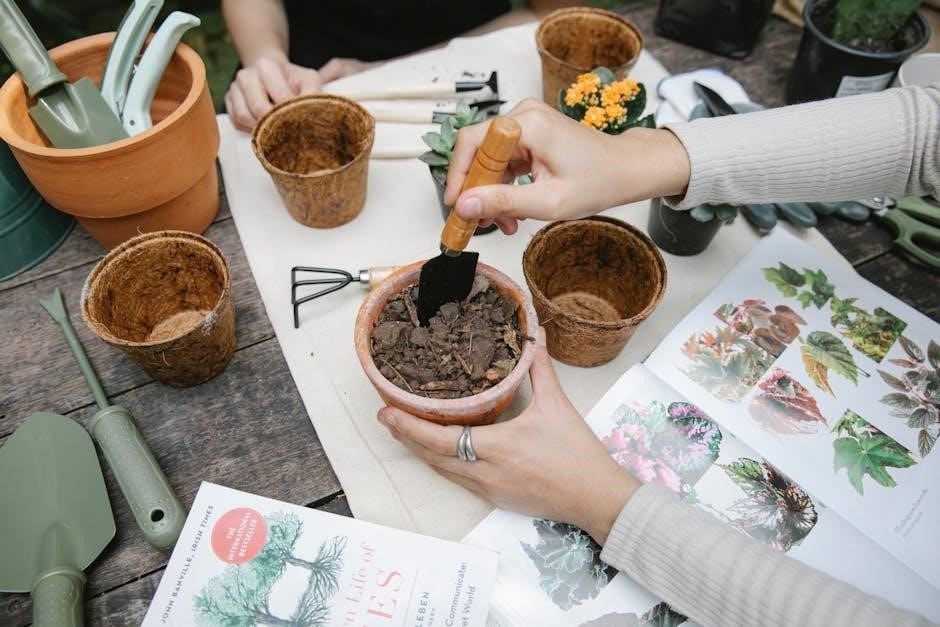Welcome to the Zone 8a Planting Guide, your essential resource for gardening success in USDA Hardiness Zone 8a. This guide helps you navigate the region’s unique climate, with a last frost date around April 1st and first frost date near December 1st, offering a long growing season. Whether you’re growing vegetables, fruits, or flowers, understanding your planting zone ensures thriving plants and a bountiful harvest. Explore monthly planting calendars, soil tips, and expert advice tailored to Zone 8a’s warm climate and diverse planting opportunities.
Overview of USDA Hardiness Zone 8a
USDA Hardiness Zone 8a is characterized by a minimum winter temperature of 10°F to 15°F (-12°C to -9°C). This zone encompasses regions with warm summers and mild winters, allowing for a long growing season. Geographically, it includes parts of states like Texas, Louisiana, and North Carolina. Gardeners in Zone 8a benefit from the ability to grow a wide variety of plants, including cool-season crops in early spring and warm-season crops throughout summer. The last frost date typically falls in late March to early April, while the first frost occurs in late November to early December, providing ample time for multiple harvests.
Key Characteristics of Zone 8a Climate
Zone 8a experiences a temperate climate with hot summers and mild winters. The average annual extreme temperature ranges from 10°F to 15°F, allowing for a prolonged growing season. Summers are warm, with temperatures often exceeding 90°F, while winters are cool but rarely harsh. This climate supports the growth of both cool-season and warm-season crops. The zone’s moderate winters and extended summers make it ideal for planting a wide variety of plants, including vegetables, fruits, and flowers. The region’s climate also influences soil conditions, requiring specific strategies for watering and mulching to maintain plant health throughout the year.
Importance of Understanding Your Planting Zone
Understanding your planting zone is crucial for successful gardening, as it determines which plants thrive in your area. Zone 8a’s climate, with its hot summers and mild winters, influences planting schedules and plant selection. Knowing your zone helps you avoid frost damage and ensures plants receive adequate growing time. It also guides soil preparation, watering, and pest management strategies. By aligning your gardening practices with Zone 8a’s conditions, you can optimize plant health, reduce losses, and enjoy a productive garden year-round. This knowledge is key to making informed decisions and achieving the best results for your specific region.

Best Plants for Zone 8a
Zone 8a supports a wide variety of plants, including vegetables like broccoli and cauliflower, fruits such as cantaloupe and watermelon, and flowers like dahlias and lilies. Herbs like thyme also thrive, making it ideal for diverse gardens. The long growing season allows plants to mature successfully, ensuring a bountiful harvest and vibrant blooms throughout the year.
Vegetables Ideal for Zone 8a
Zone 8a’s long growing season makes it perfect for a variety of vegetables. Cool-season crops like broccoli, cauliflower, and peas thrive when planted in early spring or late summer. Root vegetables such as carrots and beets grow well in Zone 8a’s climate. Warm-season crops like tomatoes, peppers, and eggplants also excel, benefiting from the region’s hot summers. Successive planting of sweet corn and beans ensures a continuous harvest. Plant cool-season crops in February and warm-season varieties after the last frost date. Proper spacing, soil preparation, and consistent watering are key to maximizing yields in Zone 8a’s favorable conditions.
Fruits and Berries Suitable for Zone 8a
Zone 8a’s warm climate supports a wide variety of fruits and berries. Cantaloupe and watermelon thrive in the region’s hot summers, while blackberries and raspberries grow well when planted in late winter or early spring. Strawberries and blueberries are excellent choices, preferring the cooler months of early spring for planting. Figs and grapes also excel in Zone 8a, benefiting from the long growing season. Ensure these plants receive well-drained soil and full sun for optimal growth. Regular watering and proper care will yield abundant harvests of delicious fruits and berries throughout the year in Zone 8a’s favorable conditions.
Flowers That Thrive in Zone 8a
Zone 8a’s climate is ideal for growing a variety of vibrant flowers. Drought-tolerant options like thyme, sea thrift, and creeping potentilla are perfect for sunny spots. White Dutch clover and sedum also thrive, requiring minimal maintenance. For colorful blooms, consider planting lilies and dahlias, which excel in Zone 8a’s warm conditions. These flowers prefer well-drained soil and full sun, making them ideal for the region’s long growing season. With proper care, these blooms will add beauty and vibrancy to your garden year-round, ensuring a stunning display of color and resilience in Zone 8a’s climate.
Herbs Perfect for Zone 8a Gardens
Zone 8a’s warm climate is perfect for growing a variety of herbs. Basil thrives in the heat and can be planted in early spring or late summer. Rosemary and lavender, both drought-tolerant, excel in well-drained soil and full sun. Oregano and thyme are also ideal, requiring minimal care and preferring dry conditions. Mint, while hardy, should be contained to prevent spreading. For cooler-loving herbs like cilantro and parsley, plant in early spring or late fall to avoid bolting. These herbs add fresh flavor and fragrance to your garden, making Zone 8a a herb gardener’s paradise with its long growing season;

Monthly Planting Calendar for Zone 8a
Zone 8a’s planting calendar is divided into four main seasons. Winter (Dec-Feb) is ideal for planting cool-season crops like broccoli and kale, as well as bulbs. Spring (Mar-May) kicks off with starting seeds indoors for tomatoes and peppers, transitioning to direct sowing of warm-season crops like corn and beans. Summer (Jun-Aug) focuses on heat-tolerant plants such as okra and squash, with succession planting for continuous harvests. Fall (Sep-Nov) sees the return of cool-weather crops like spinach and carrots, with preparation for winter gardens. Each season offers unique planting opportunities, ensuring year-round growth in Zone 8a’s favorable climate. Always check local forecasts to optimize planting success.
Winter Planting (December to February)
Winter in Zone 8a offers a cool yet manageable climate for planting a variety of crops. Cool-season vegetables like spinach, kale, and broccoli thrive during this period. Plant bulbs such as tulips and daffodils in December for vibrant spring blooms. Root vegetables like carrots and beets can also be direct-sown. Late winter is ideal for starting seeds indoors for early spring transplants, such as tomatoes and peppers. Protect sensitive plants from frost using mulch or row covers. Soil preparation is key; ensure it’s well-draining and enriched with organic matter. Winter planting in Zone 8a allows for a head start on the growing season, ensuring a continuous harvest cycle. Proper care ensures healthy growth during cooler months. This period is also perfect for planning and preparing for the upcoming gardening year, making it a crucial part of your Zone 8a planting strategy. With the right techniques, your winter garden can be productive and rewarding. Consider the specific needs of each plant to maximize success. Always monitor weather conditions and adjust planting schedules accordingly to protect your crops from extreme cold snaps. Incorporating companion planting can further enhance growth and deter pests, making your winter garden thrive. By following these guidelines, you can enjoy fresh produce and beautiful blooms even during the colder months in Zone 8a.
Spring Planting (March to May)
Spring in Zone 8a is an ideal time to plant a variety of crops as the weather warms up. Begin with cool-season vegetables like spinach, lettuce, and peas in early March, followed by root crops such as carrots and radishes. As temperatures rise, transition to warm-season plants like tomatoes, peppers, and zucchini after the last frost date, typically around April 1st. Start seeds indoors for transplants in early March and move them outside as the soil warms. Incorporate flowers like marigolds and sunflowers to attract pollinators. Herbs such as basil and cilantro also thrive during this period. Ensure soil is well-prepared and consistently moist for optimal growth. Monitor weather conditions to protect young plants from unexpected frosts. Proper spacing and sunlight exposure are key for healthy development. This season offers a wide range of planting opportunities, making it a busy and rewarding time for Zone 8a gardeners. Plan carefully to maximize your garden’s potential during these months. With the right strategy, your spring garden will flourish, providing fresh produce and vibrant blooms throughout the season. Regular maintenance and pest control will help ensure a successful harvest. Enjoy the bounty of your spring planting efforts in Zone 8a as the growing season progresses. By following these guidelines, you can make the most of the spring planting window in your region. This period is crucial for setting up a productive and diverse garden. Take advantage of the mild weather to establish a strong foundation for the upcoming growing season. Spring planting in Zone 8a is a time of renewal and growth, offering endless possibilities for gardeners. Make the most of this season to cultivate a thriving and abundant garden. With proper care and attention, your spring plants will flourish, providing you with fresh produce and beautiful blooms for months to come; This is an exciting time to get your hands dirty and watch your garden come to life. Take advantage of the favorable conditions to plant a wide variety of crops and enjoy the fruits of your labor throughout the year. Spring planting in Zone 8a is a key part of a successful gardening strategy, setting the stage for a productive and enjoyable growing season. By planting at the right time and caring for your plants properly, you can achieve a bountiful harvest and a stunning display of flowers. This season is a great opportunity to try new plants and experiment with different gardening techniques. With the right approach, your spring garden will be a source of joy and nourishment. Make the most of Zone 8a’s spring planting season to create a garden that thrives and brings you satisfaction throughout the year. Spring planting is a time of growth and renewal, offering countless possibilities for gardeners in Zone 8a. By following the guidelines and tips outlined here, you can make the most of this season and enjoy a successful and rewarding gardening experience. This is the perfect time to plant a wide range of crops and set the stage for a productive growing season. With careful planning and proper care, your spring garden will flourish, providing you with fresh produce and beautiful blooms for months to come. Take advantage of the mild weather and long growing season in Zone 8a to create a garden that is both productive and visually appealing. This is an exciting time to get started and watch your garden grow. By planting at the right time and following best practices, you can ensure a successful and enjoyable spring gardening experience in Zone 8a. Spring planting is a critical part of gardening in this zone, offering a wide range of opportunities to grow delicious vegetables, vibrant flowers, and fragrant herbs. With the right strategy and care, your spring garden will thrive, providing you with a bountiful harvest and a beautiful display of color. This is the time to get your hands dirty and make the most of Zone 8a’s favorable spring conditions. By following the guidelines and tips provided, you can create a garden that is both productive and enjoyable. Spring planting in Zone 8a is a time of endless possibilities, and with the right approach, you can achieve a successful and rewarding gardening experience. This season is a great opportunity to plant a variety of crops and set the stage for a thriving garden. With proper care and attention, your spring plants will flourish, providing you with fresh produce and beautiful blooms throughout the growing season. Make the most of Zone 8a’s spring planting season to create a garden that brings you joy and nourishment. This is the perfect time to try new plants and experiment with different gardening techniques. By following the advice outlined here, you can ensure a successful and enjoyable spring gardening experience. Spring planting in Zone 8a is a time of growth and renewal, offering countless opportunities to grow a wide range of crops. With the right strategy and care, your garden will thrive, providing you with a bountiful harvest and a stunning display of color. This is an exciting time to get started and watch your garden come to life. By planting at the right time and following best practices, you can make the most of Zone 8a’s spring planting season. Spring is a time of renewal and growth in Zone 8a, offering gardeners a wide range of planting opportunities. By following the guidelines and tips provided, you can create a garden that is both productive and visually appealing. This is the perfect time to plant a variety of crops and enjoy the fruits of your labor throughout the growing season. With proper care and attention, your spring plants will flourish, providing you with fresh produce and beautiful blooms. Make the most of Zone 8a’s spring planting season to create a garden that brings you joy and satisfaction. This is an exciting time to get your hands dirty and watch your garden grow. By planting at the right time and following best practices, you can ensure a successful and rewarding gardening experience. Spring planting in Zone 8a is a critical part of achieving a productive and enjoyable garden. With the right approach, you can make the most of this season and enjoy a bountiful harvest. This is the time to try new plants and experiment with different gardening techniques. By following the advice outlined here, you can create a garden that thrives and brings you joy throughout the year. Spring planting in Zone 8a is a time of endless possibilities, offering a wide range of opportunities to grow delicious vegetables, vibrant flowers, and fragrant herbs. With the right strategy and care, your garden will flourish, providing you with a successful and rewarding gardening experience. This is the perfect time to get started and make the most of Zone 8a’s favorable spring conditions. By planting at the right time and following best practices, you can ensure a thriving and productive garden. Spring planting in Zone 8a is a time of growth and renewal, offering gardeners a chance to create a beautiful and bountiful garden. With the right approach, you can make the most of this season and enjoy a successful gardening experience. This is the time to plant a wide range of crops and set the stage for a productive growing season. By following the guidelines and tips provided, you can ensure your spring garden thrives and provides you with fresh produce and beautiful blooms. Make the most of Zone 8a’s spring planting season to create a garden that brings you joy and nourishment. This is an exciting time to get your hands dirty and watch your garden come to life. By planting at the right time and following best practices, you can achieve a successful and rewarding gardening experience. Spring planting in Zone 8a is a time of endless possibilities, offering a wide range of opportunities to grow delicious vegetables, vibrant flowers, and fragrant herbs. With the right strategy and care, your garden will thrive, providing you with a bountiful harvest and a beautiful display of color. This is the perfect time to try new plants and experiment with different gardening techniques. By following the advice outlined here, you can create a garden that is both productive and enjoyable. Spring planting in Zone 8a is a critical part of achieving a successful and rewarding gardening experience. With the right approach, you can make the most of this season and enjoy a bountiful harvest. This is the time to get started and make the most of Zone 8a’s favorable spring conditions. By planting at the right time and following best practices, you can ensure a thriving and productive garden. Spring planting in Zone 8a is a time of growth and renewal, offering gardeners a wide range of planting opportunities. By following the guidelines and tips provided, you can create a garden that is both productive and visually appealing. This is the perfect time to plant a variety of crops and enjoy the fruits of your labor throughout the growing season. With proper care and attention, your spring plants will flourish, providing you with fresh produce and beautiful blooms. Make the most of Zone 8a
Summer Planting (June to August)
Summer in Zone 8a is characterized by warm weather, making it ideal for planting heat-tolerant crops. Vegetables like okra, southern peas, and squash thrive in these conditions. Plant heat-resistant tomatoes and peppers, and consider drought-tolerant herbs like basil and mint. Flowers such as zinnias, marigolds, and sunflowers also flourish during this time. Ensure consistent watering and mulching to retain soil moisture and protect roots from heat stress. Incorporate afternoon shade for sensitive plants to prevent scorching. Summer is also a great time to propagate perennials and divide mature plants. Regular monitoring and pest management are essential to maintain healthy growth. This period offers a vibrant and productive gardening experience in Zone 8a.
Fall Planting (September to November)
Fall planting in Zone 8a is ideal for cool-season crops, as the moderate temperatures promote healthy growth. Broccoli, kale, spinach, and carrots thrive during this period. Plant bulbs like garlic and shallots in October for a spring harvest. Direct sow crops such as radishes, beets, and lettuce, while starting seeds indoors for Brussels sprouts and cabbage. Soil preparation is key; amend with compost for nutrient-rich ground. Mulch around plants to retain moisture and regulate soil temperature. Ensure proper spacing and consistent watering, especially as the weather cools. Fall planting extends the gardening season, allowing for a bountiful harvest before winter arrives. Plan according to local frost dates for optimal results.
Soil Preparation and Care
Testing and amending soil is crucial for Zone 8a gardens. Aim for a pH between 6.0 and 7.0, adding compost or manure to enrich soil structure. Proper drainage and nutrient balance ensure healthy plant growth, especially for vegetables and flowers. Regularly monitor soil conditions to maintain fertility and support diverse plant needs throughout the growing season.
Testing and Amending Soil for Zone 8a
Testing your soil is essential to determine its pH level and nutrient content. For Zone 8a, aim for a pH between 6.0 and 7.0, ideal for most vegetables and flowers. If your soil is too acidic, add lime; if too alkaline, incorporate elemental sulfur or peat moss. Organic matter like compost or well-rotted manure enriches soil structure and fertility. Test your soil annually to monitor changes and adjust amendments accordingly. Proper soil preparation ensures robust plant growth and maximizes yields. Avoid over-amending, as this can harm plants. Regular testing and balanced amendments create a thriving environment for your Zone 8a garden.
Optimal Soil Conditions for Different Plants
Different plants thrive in varying soil conditions. Vegetables like tomatoes and peppers prefer well-drained, fertile soil rich in organic matter. Fruits and berries, such as strawberries and blueberries, often require slightly acidic soil. Flowers like roses and lavender benefit from balanced, slightly alkaline soils. Herbs, including thyme and rosemary, excel in dry to moderately moist, well-drained soils. Native plants typically adapt well to local soil types but may need adjustments based on specific species. Understanding these preferences ensures you create the best environment for diverse plants in your Zone 8a garden, promoting healthy growth and productivity throughout the season.
Watering and Mulching Tips
Consistent moisture and proper drainage are crucial for Zone 8a plants. Mulching helps retain moisture, suppress weeds, and regulate soil temperature. Apply 2-3 inches of organic mulch.
Watering Strategies for Zone 8a Gardens
Zone 8a gardens require thoughtful watering to balance the region’s warm, dry summers and mild winters. Aim to provide about 1-2 inches of water weekly, either through rainfall or irrigation. Water deeply but infrequently to encourage root depth, making plants more drought-resistant. Avoid frequent shallow watering, which can lead to weak root systems. Use drip irrigation or soaker hoses to minimize evaporation and deliver water directly to roots. Mulch around plants to retain soil moisture and reduce evaporation. Monitor soil moisture by inserting a finger into the soil up to the knuckle; water only when the soil feels dry. Avoid overwatering, as it can lead to root rot and other issues. Adjust watering schedules during extreme heatwaves, ensuring plants receive adequate hydration without waterlogging the soil. Proper watering strategies will help your Zone 8a garden thrive throughout the growing season.
Best Mulching Practices for Zone 8a
Mulching is a key strategy for Zone 8a gardens, helping retain moisture, suppress weeds, and regulate soil temperature. Use organic mulches like wood chips, bark, or straw, applying a 2-3 inch layer around plants. Avoid mulching too close to stems or trunks to prevent rot. Replenish mulch as needed, especially after heavy rains or extreme heat. Inorganic options like gravel or plastic sheeting can also be effective, especially for pathways. Mulch helps reduce evaporation, keeping the soil cool during Zone 8a’s hot summers. Proper mulching practices ensure healthier plants and a more sustainable garden ecosystem throughout the growing season.

Common Challenges in Zone 8a Gardening
Zone 8a gardeners face challenges like intense heat, drought, and pests. Soil degradation and nutrient depletion are also concerns due to the region’s warm climate and high humidity.
Managing Heat Stress in Plants
Heat stress is a significant challenge in Zone 8a, where summer temperatures soar. Plants may wilt, drop leaves, or experience reduced growth. To mitigate this, ensure proper watering schedules, providing consistent moisture without overwatering. Mulching can help retain soil moisture and regulate temperature. Selecting heat-tolerant varieties is crucial, as they are bred to withstand high temperatures. Providing afternoon shade, especially for sensitive plants, can offer relief. Monitoring soil temperature and adjusting planting times to avoid peak heat periods are also effective strategies. Regularly inspecting plants for signs of stress allows for timely intervention, ensuring your garden thrives despite the heat.
Pest and Disease Management in Zone 8a
Pest and disease management is critical in Zone 8a due to its warm climate, which fosters pest activity and fungal growth. Common pests include aphids, whiteflies, and slugs, while diseases like powdery mildew and root rot can thrive in moist conditions. Regular inspection and organic controls, such as neem oil and insecticidal soap, are effective. Crop rotation and biological controls, like ladybugs, help maintain balance. Overwatering can exacerbate root issues, so proper drainage and watering techniques are essential. Early detection and treatment prevent widespread damage. Implementing integrated pest management strategies ensures a healthy, productive garden in Zone 8a’s challenging environment.

Native Plants for Zone 8a
Native plants are perfectly adapted to Zone 8a’s climate, requiring less maintenance and supporting local biodiversity. They attract pollinators like bees and butterflies, are naturally pest- and disease-resistant, and add beauty to gardens. Popular choices include Texas Sage, Lantana, and Black-Eyed Susan, which thrive in the region’s warm conditions.
Benefits of Growing Native Plants
Native plants offer numerous benefits for Zone 8a gardens. They are naturally adapted to the local climate, requiring less water and care compared to non-native species. This makes them ideal for low-maintenance gardening. Native plants also support local ecosystems by attracting pollinators like bees and butterflies, promoting biodiversity. They are often more resistant to pests and diseases, reducing the need for pesticides. Additionally, native plants help maintain soil health and prevent erosion. By choosing native species, gardeners contribute to environmental sustainability while enjoying vibrant, resilient plants that enhance the beauty of their outdoor spaces throughout the growing season.
Popular Native Species for Zone 8a Gardens
Zone 8a gardens thrive with native species like Texas Sage, Black-Eyed Susan, and Lantana, which are drought-tolerant and attract pollinators. Native grasses such as Little Bluestem and Switchgrass add texture and stability to landscapes. Shrubs like American Beautyberry and Wax Myrtle provide vibrant fall colors and berries for wildlife. These plants are well-suited to the region’s warm climate and require minimal maintenance. Incorporating native species enhances biodiversity, supports local ecosystems, and creates a stunning, resilient garden. They also serve as a natural food source for birds and butterflies, making them a popular choice for eco-conscious gardeners in Zone 8a.
Using a Planting Chart for Zone 8a
A planting chart for Zone 8a provides a detailed guide to sowing seeds, transplanting, and harvesting, ensuring optimal timing for vegetables, flowers, and herbs throughout the season.
How to Read and Use a Planting Chart
To effectively use a planting chart for Zone 8a, start by identifying the specific sections for your region. Most charts list plants alphabetically or by category, such as vegetables, fruits, or flowers. Look for the “planting time” column, which often includes months or dates for sowing seeds or transplanting. Pay attention to spacing and depth guidelines to ensure proper growth. Note any recommendations for soil preparation or sunlight requirements. Adjust the timeline based on local weather patterns, as frost dates and temperature fluctuations can vary. Use the chart to plan succession plantings, ensuring a continuous harvest throughout the growing season. This tool simplifies gardening by providing a clear, organized schedule tailored to Zone 8a’s climate.
Creating a Personalized Planting Schedule
Creating a personalized planting schedule for Zone 8a involves tailoring general guidelines to your specific garden conditions and preferences. Start by listing the plants you wish to grow, noting their maturity days and spacing requirements from the planting chart. Consider your garden’s microclimate, soil type, and sunlight exposure. Plan for succession planting to ensure a continuous harvest, especially for crops like lettuce and tomatoes. Use a calendar or spreadsheet to map out start dates, transplantation times, and expected harvest periods. Be flexible to adjust based on weather variations and frost dates. This personalized approach maximizes your garden’s productivity and aligns with Zone 8a’s unique growing conditions.



